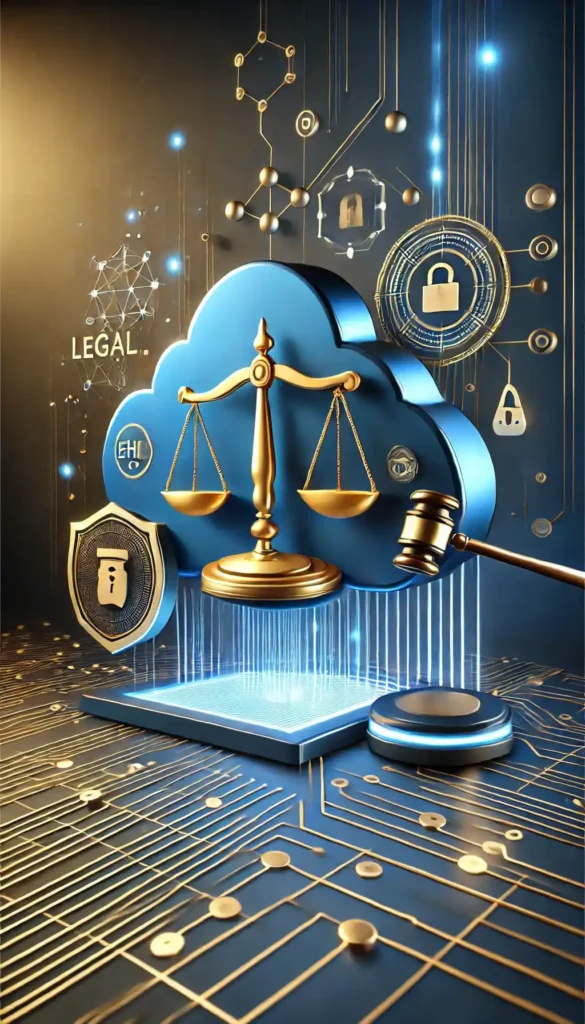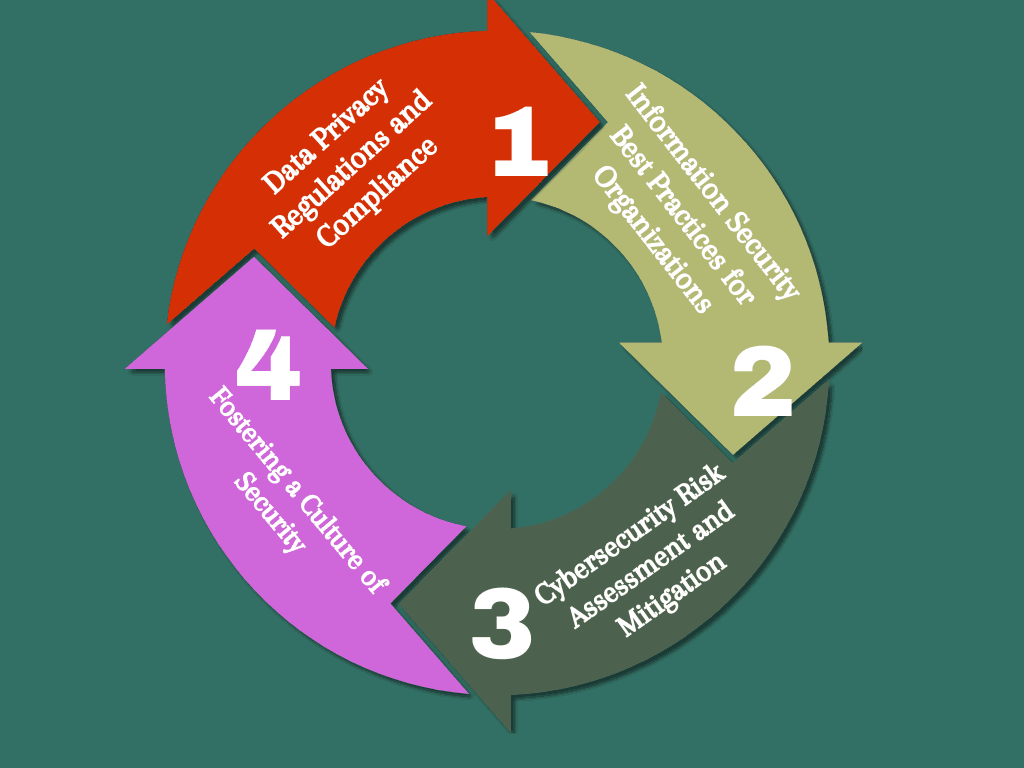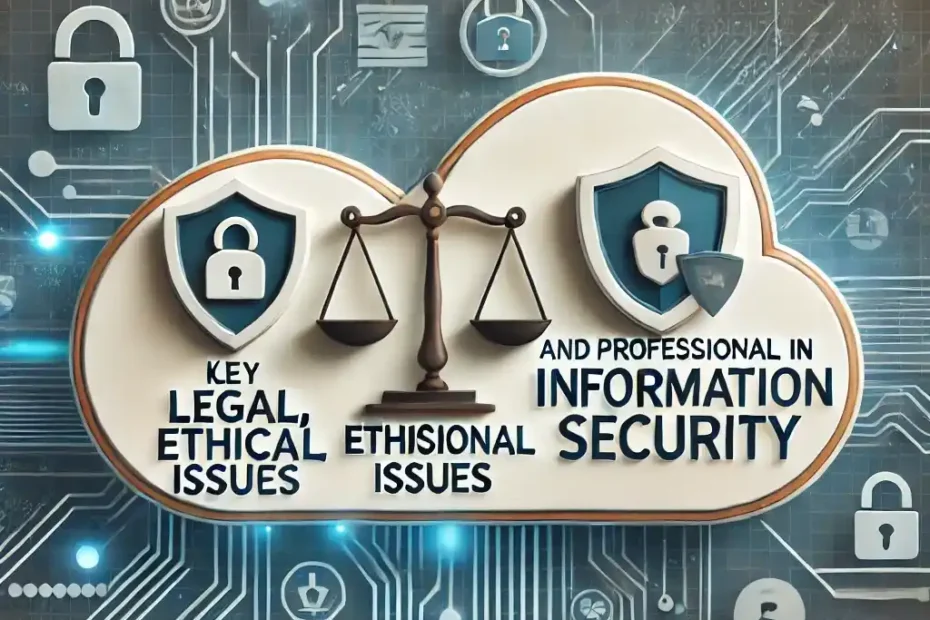1. Introduction
1 Definition and Scope of Information Security
Information security involves protecting sensitive data, networks, and systems from unauthorized access, misuse, or harm. It ensures the confidentiality, integrity, and availability of information in both digital and physical forms. With the rise of cyber threats, safeguarding information has become essential for individuals, organizations, and governments. Effective information security measures not only protect valuable assets but also contribute to organizational stability and customer trust.
2 Importance of Addressing Legal, Ethical, and Professional Issues
Legal, ethical, and professional considerations are essential in building trust, maintaining compliance, and ensuring the smooth functioning of organizations. Ignoring these issues can lead to legal penalties, reputational damage, and loss of customer trust. By understanding and addressing these concerns, organizations can create a secure and ethical digital environment. Furthermore, addressing these issues ensures adherence to global standards, fostering a culture of accountability and integrity.
2. Legal Issues in Information Security

1 Information Security Laws and Cybercrime Laws
Information security laws establish the legal framework for protecting data and prosecuting cybercriminals. Laws like the Computer Fraud and Abuse Act (CFAA) and similar regulations are designed to prevent unauthorized access and safeguard against data breaches.
2 Data Protection Legislation and Privacy Laws in Information Technology
Laws such as GDPR and CCPA regulate the collection, use, and storage of personal data to ensure user privacy and data security.
3 Legal Aspects of Cloud Computing
Cloud computing introduces complexities in data jurisdiction and compliance. Legal agreements must define responsibilities for security and liability.
4 Data Breach Notification Laws
These laws require organizations to promptly inform affected stakeholders and authorities about breaches, encouraging transparency and swift action.
5 Intellectual Property in IT
Intellectual property laws protect software, digital creations, and innovations, ensuring fair usage and rewarding innovation.
6 Digital Forensics and Legal Issues
Digital forensics provides evidence for cybercrime investigations but must adhere to strict legal standards to ensure admissibility in court.
3. Ethical Issues in Information Security

1 Computer Ethics and Professional Ethics in Computer Science
Computer ethics refer to the moral principles guiding the use and development of technology. In information security, professionals are expected to protect user data, respect privacy, and avoid unethical practices such as unauthorized access or manipulation of data. Professional ethics in computer science emphasize accountability, integrity, and transparency, ensuring that IT experts act responsibly in protecting sensitive information.
For example, developers must ensure their systems do not exploit users or compromise privacy. They are also responsible for creating systems that are fair and unbiased, especially in sensitive areas such as financial services or healthcare.
2 Balancing Privacy and Security in IT
Finding the right balance between privacy and security remains a significant ethical challenge.. Security measures like surveillance and data collection are essential to prevent cyber threats, but excessive monitoring can infringe on personal privacy. Organizations must navigate this fine line, implementing measures that protect data without violating individual rights.
An example of this balance can be seen in workplace monitoring. While employers may monitor systems to detect insider threats, they must ensure their practices do not unjustly invade employees’ privacy, adhering to legal and ethical guidelines.
3 Ethical Hacking Guidelines
Ethical hacking involves identifying vulnerabilities in systems to prevent potential breaches. Ethical hackers, or white-hat hackers, operate with permission and follow strict guidelines to ensure their work benefits the organization without causing harm.
For instance, ethical hacking contracts often include non-disclosure agreements (NDAs) to protect the organization’s sensitive data. Following these guidelines ensures that ethical hackers maintain integrity and professionalism in their work.
4 Ethical Issues in Artificial Intelligence
Artificial intelligence (AI) introduces unique ethical challenges in information security. AI systems are often used to detect and respond to cyber threats, but their effectiveness depends on the data they are trained on. If this data is biased, the AI may make unfair or inaccurate decisions.
For example, facial recognition technology has faced criticism for racial biases. Addressing such ethical concerns involves ensuring AI algorithms are transparent, unbiased, and accountable for their decisions.
5 Managing Insider Threats Ethically
Insider threats occur when employees or trusted individuals misuse their access to harm an organization. Addressing this requires ethical policies that balance security with employee privacy. For example, monitoring employee activities to detect insider threats must be done transparently, with clear communication and adherence to privacy laws.
Organizations can also reduce insider threats through ethical practices such as fostering a positive workplace culture, providing security training, and implementing strict access controls. These measures not only enhance security but also build trust among employees
4. Professional Conduct and Certifications in IT Security
1 Codes of Conduct for IT Security Professionals
A code of conduct is a set of principles that guide IT security professionals in their roles. These principles emphasize integrity, confidentiality, and respect for others’ privacy. For instance, IT professionals are expected to protect sensitive data, report security vulnerabilities responsibly, and avoid conflicts of interest.
Organizations often adopt industry-standard codes, such as those provided by (ISC)² for CISSP-certified professionals, to ensure employees adhere to ethical and professional standards. Following these codes fosters trust and strengthens the cybersecurity community.
2 Professional Accountability and Ethical Behavior
Accountability in IT security means taking responsibility for one’s actions and decisions. For example, a security professional must ensure that any systems they implement comply with legal standards and do not compromise user privacy. Ethical behavior includes prioritizing the security of users’ data over personal or organizational gain.
An accountable professional will promptly address breaches, report incidents transparently, and continuously strive to improve security measures. This commitment to ethical behavior helps maintain credibility and trust in the profession.

3 Information Security Certifications
Certifications play a crucial role in validating the skills and knowledge of IT security professionals. They provide a benchmark for expertise and demonstrate a commitment to maintaining high standards. Some widely recognized certifications include:
- Certified Information Systems Security Professional (CISSP): Focuses on managing and implementing security programs.
- Certified Information Security Manager (CISM): Emphasizes governance and risk management.
- Certified Ethical Hacker (CEH): Specializes in penetration testing and ethical hacking techniques.
These certifications not only enhance career prospects but also ensure professionals are equipped to handle complex security challenges effectively.
4 Ensuring Competency Through Continuing Education
The field of information security evolves rapidly, with new threats and technologies emerging constantly. Ongoing education is crucial for professionals to remain current and informed. Training programs, industry conferences, and advanced certifications help professionals deepen their expertise and adapt to changes.
For example, attending events like Black Hat or DEF CON allows professionals to learn from real-world security scenarios and innovative solutions. Organizations can support continuing education by providing access to learning resources and encouraging participation in relevant training programs.
5 The Role of Professional Organizations in IT Security
Professional organizations like (ISC)², ISACA, and EC-Council play a significant role in upholding professional conduct and offering certifications. These organizations provide resources, networking opportunities, and guidance on emerging trends in cybersecurity.
Membership in such organizations also ensures that professionals remain aligned with industry standards and ethical practices, contributing to the overall integrity and reliability of the field
5. Best Practices in Information Security

1 Data Privacy Regulations and Compliance
Adhering to data privacy regulations is a cornerstone of effective information security practices. Laws such as the General Data Protection Regulation (GDPR) and the California Consumer Privacy Act (CCPA) set clear expectations for how organizations should collect, store, and use personal data.
Organizations must ensure compliance by:
- Implementing Privacy Policies: Transparent policies that explain how data is used.
- Conducting Regular Audits: Periodic assessments to ensure systems comply with regulations.
- Employee Training: Educating staff on privacy laws and secure data handling practices.
For example, a company handling customer financial information must encrypt sensitive data and limit access to authorized personnel. Failing to comply with these regulations can result in hefty fines and loss of customer trust.
2 Information Security Best Practices for Organizations
Organizations must adopt robust security practices to safeguard their systems and data. Some key best practices include:
- Regular Security Audits: Periodic reviews to identify vulnerabilities and ensure systems are secure.
- Multi-Factor Authentication (MFA): Requiring multiple forms of verification for system access.
- Data Encryption:Securing sensitive data through encryption, whether stored or in transit, is vital to prevent unauthorized access.
- Patch Management: Keeping systems and software up-to-date to address known vulnerabilities.
- Employee Awareness Training: Ensuring employees recognize phishing attempts, social engineering tactics, and other threats.
For instance, implementing MFA and encryption can prevent unauthorized access, even if credentials are compromised. Employee awareness programs further reduce risks by addressing human error, which is often the weakest link in security.
3 Cybersecurity Risk Assessment and Mitigation
Risk assessment involves identifying potential threats, evaluating their impact, and prioritizing responses. A proactive approach to risk mitigation ensures that vulnerabilities are addressed before they are exploited.
Steps to conduct a risk assessment include:
- Asset Identification: Determining what needs protection, such as databases, systems, and applications.
- Threat Analysis: Identifying potential risks, such as malware, ransomware, or insider threats.
- Vulnerability Assessment: Evaluating weaknesses in existing systems.
- Implementation of Mitigation Strategies: Applying controls like firewalls, intrusion detection systems, and regular backups.
For example, a retail company might assess the risk of a data breach affecting its point-of-sale (POS) system. Implementing strong access controls and encryption ensures that even if the POS system is targeted, sensitive payment information remains secure.
4 Fostering a Culture of Security
Creating a culture of security is critical to ensuring that best practices are consistently followed. This includes:
- Leadership Commitment: Senior management must lead by example and prioritize security.
- Clear Policies and Procedures: Employees should have easy access to guidelines for secure behavior.
- Regular Updates: Security protocols must evolve alongside emerging threats.
Organizations with a strong culture of security are better equipped to adapt to new challenges and maintain a resilient security posture.
7. Future Trends and Challenges in Information Security
1 The Rise of Artificial Intelligence in Cybersecurity
Artificial intelligence (AI) is revolutionizing cybersecurity by enhancing the speed and efficiency of threat detection and response. AI tools analyze vast amounts of data to identify unusual patterns and predict security breaches. They are used for detecting malware, automating responses to incidents, and monitoring user behavior for signs of insider threats. However, attackers are also using AI to create advanced malware and conduct automated attacks, making it essential for organizations to stay ahead in this technology race.
2 Challenges with Cloud Security
Cloud security remains a critical challenge as organizations increasingly rely on cloud services. Misconfigured storage and weak access controls are common vulnerabilities that lead to data breaches. Additionally, compliance with data protection laws becomes more complex when data is stored across multiple jurisdictions. Solutions include implementing encryption, multi-factor authentication, and regular monitoring to secure sensitive information in cloud environments.
3 The Internet of Things (IoT) Security Risks
The rapid expansion of IoT devices has increased the attack surface for cybercriminals. Many IoT devices lack proper security measures, such as strong authentication or regular updates, making them vulnerable to exploitation. To improve security, organizations need to enforce encryption, monitor device traffic, and require manufacturers to follow stringent security standards.
4 Evolving Cyber Threats and Attack Vectors
Cyber threats are becoming more sophisticated as attackers develop new techniques to exploit vulnerabilities. Ransomware-as-a-service makes ransomware easily accessible to criminals, while deepfake technology is being used for fraud and manipulation. Supply chain attacks target third-party vendors, compromising entire networks. Organizations must prioritize proactive threat intelligence, implement strong security frameworks, and regularly assess vulnerabilities to mitigate these evolving threats.
5 The Role of Quantum Computing in Cybersecurity
Quantum computing presents considerable challenges to traditional encryption techniques. Quantum computers can break many current cryptographic algorithms, potentially exposing sensitive data. Efforts are underway to develop quantum-resistant encryption to secure future systems. These advancements will ensure that organizations remain protected in the age of quantum computing.
6 Building a Resilient Security Future
Organizations are shifting their focus from reactive to proactive measures by adopting resilient security practices. Zero-trust architectures are being widely implemented to ensure strict verification of all users and devices accessing systems. Cybersecurity training and awareness programs are equipping employees to recognize and respond to threats. Collaboration between governments, industries, and researchers is fostering the development of robust global security frameworks.
8 Difference Between Artificial Intelligence in Cybersecurity and Traditional Cybersecurity Approaches
| Aspect | Artificial Intelligence in Cybersecurity | Traditional Cybersecurity Approaches |
|---|---|---|
| Threat Detection | Identifies threats using machine learning, detecting patterns and anomalies. | Detects threats based on known signatures and pre-defined rules. |
| Response Time | Automates response to incidents, enabling real-time reaction to threats. | Requires manual investigation and action, leading to delays. |
| Adaptability | Learns and evolves to handle new and unknown (zero-day) threats effectively. | Limited to addressing known threats; needs frequent updates for new ones. |
| Scalability | Processes and analyzes large amounts of data seamlessly across networks. | Struggles to handle increasing data volume without performance loss. |
| Resource Utilization | Reduces workload by automating repetitive tasks like log analysis. | Relies on human resources to perform repetitive tasks, increasing effort. |
| Cost Efficiency | Higher initial investment but lowers costs over time by reducing manual effort. | Typically lower upfront costs but higher long-term operational expenses. |
| Human Dependency | Minimizes reliance on humans for day-to-day tasks while focusing on high-priority threats. | Requires constant human oversight for identifying and resolving issues |
9 FAQs
1. What is the role of artificial intelligence in cybersecurity?
AI in cybersecurity enhances threat detection, automates incident response, and identifies patterns or anomalies in real-time. It improves adaptability to unknown threats and reduces the reliance on manual processes.
2. How do traditional cybersecurity approaches differ from AI-based methods?
Traditional methods rely on known threat signatures and manual processes, while AI uses machine learning to detect and respond to threats dynamically, even if they are new or unknown.
3. What are the challenges of implementing AI in cybersecurity?
Challenges include high initial costs, the need for skilled personnel to manage AI systems, potential biases in machine learning models, and the risk of attackers leveraging AI for malicious purposes.
4. Why is a zero-trust architecture important for future cybersecurity?
A zero-trust architecture ensures strict verification for all users and devices accessing systems, reducing vulnerabilities and enhancing protection against sophisticated cyberattacks.
5. How does quantum computing impact current encryption methods?
Quantum computing poses a threat to traditional encryption methods by potentially breaking algorithms like RSA and ECC. Organizations must adopt quantum-resistant encryption to safeguard data in the future.
10 Conclusion
The evolving landscape of information security requires organizations to address legal, ethical, and professional challenges proactively. Adhering to data protection laws, implementing robust cybersecurity frameworks, and fostering a culture of accountability are essential to safeguard sensitive information. Emerging technologies like artificial intelligence and quantum computing offer powerful tools for securing systems but also introduce new risks and ethical dilemmas.
By adopting best practices, such as regular risk assessments, compliance with privacy regulations, and employee training, organizations can build resilient defenses against cyber threats. Collaboration among governments, industries, and researchers is equally critical to developing innovative solutions and global standards for security.
The future of information security lies in staying adaptable, leveraging advanced technologies responsibly, and prioritizing transparency and trust. Organizations that commit to these principles will be better equipped to navigate the challenges of the digital age and maintain secure, ethical, and efficient operations.
